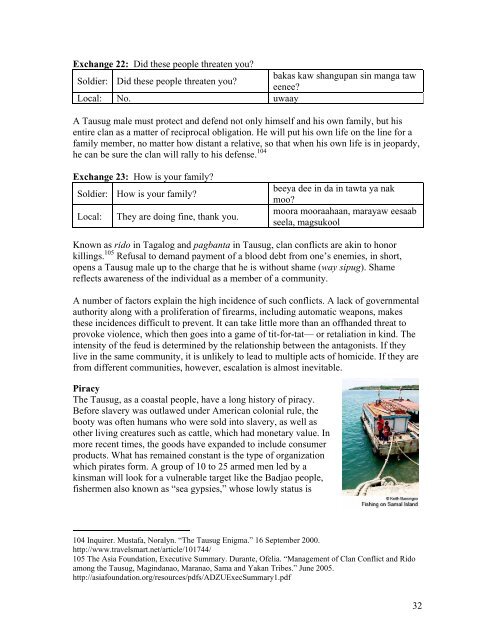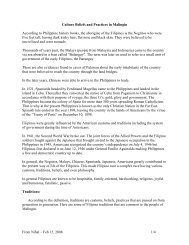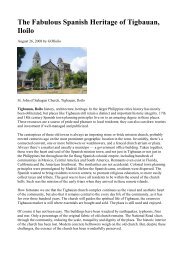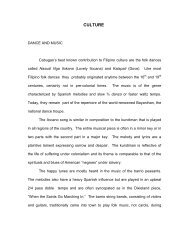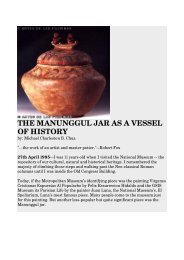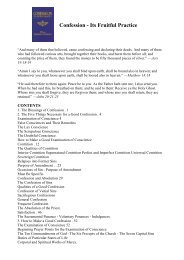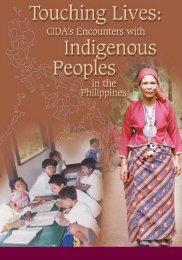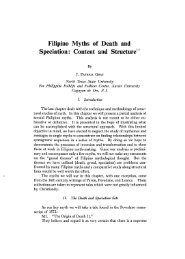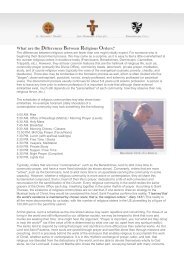Tausug Cultural Orientation - Philippine Culture
Tausug Cultural Orientation - Philippine Culture
Tausug Cultural Orientation - Philippine Culture
Create successful ePaper yourself
Turn your PDF publications into a flip-book with our unique Google optimized e-Paper software.
Exchange 22: Did these people threaten you?<br />
bakas kaw shangupan sin manga taw<br />
Soldier: Did these people threaten you?<br />
eenee?<br />
Local: No. uwaay<br />
A <strong>Tausug</strong> male must protect and defend not only himself and his own family, but his<br />
entire clan as a matter of reciprocal obligation. He will put his own life on the line for a<br />
family member, no matter how distant a relative, so that when his own life is in jeopardy,<br />
he can be sure the clan will rally to his defense. 104<br />
Exchange 23: How is your family?<br />
Soldier: How is your family?<br />
Local: They are doing fine, thank you.<br />
beeya dee in da in tawta ya nak<br />
moo?<br />
moora mooraahaan, marayaw eesaab<br />
seela, magsukool<br />
Known as rido in Tagalog and pagbanta in <strong>Tausug</strong>, clan conflicts are akin to honor<br />
killings. 105 Refusal to demand payment of a blood debt from one’s enemies, in short,<br />
opens a <strong>Tausug</strong> male up to the charge that he is without shame (way sipug). Shame<br />
reflects awareness of the individual as a member of a community.<br />
A number of factors explain the high incidence of such conflicts. A lack of governmental<br />
authority along with a proliferation of firearms, including automatic weapons, makes<br />
these incidences difficult to prevent. It can take little more than an offhanded threat to<br />
provoke violence, which then goes into a game of tit-for-tat— or retaliation in kind. The<br />
intensity of the feud is determined by the relationship between the antagonists. If they<br />
live in the same community, it is unlikely to lead to multiple acts of homicide. If they are<br />
from different communities, however, escalation is almost inevitable.<br />
Piracy<br />
The <strong>Tausug</strong>, as a coastal people, have a long history of piracy.<br />
Before slavery was outlawed under American colonial rule, the<br />
booty was often humans who were sold into slavery, as well as<br />
other living creatures such as cattle, which had monetary value. In<br />
more recent times, the goods have expanded to include consumer<br />
products. What has remained constant is the type of organization<br />
which pirates form. A group of 10 to 25 armed men led by a<br />
kinsman will look for a vulnerable target like the Badjao people,<br />
fishermen also known as “sea gypsies,” whose lowly status is<br />
104 Inquirer. Mustafa, Noralyn. “The <strong>Tausug</strong> Enigma.” 16 September 2000.<br />
http://www.travelsmart.net/article/101744/<br />
105 The Asia Foundation, Executive Summary. Durante, Ofelia. “Management of Clan Conflict and Rido<br />
among the <strong>Tausug</strong>, Magindanao, Maranao, Sama and Yakan Tribes.” June 2005.<br />
http://asiafoundation.org/resources/pdfs/ADZUExecSummary1.pdf<br />
32


